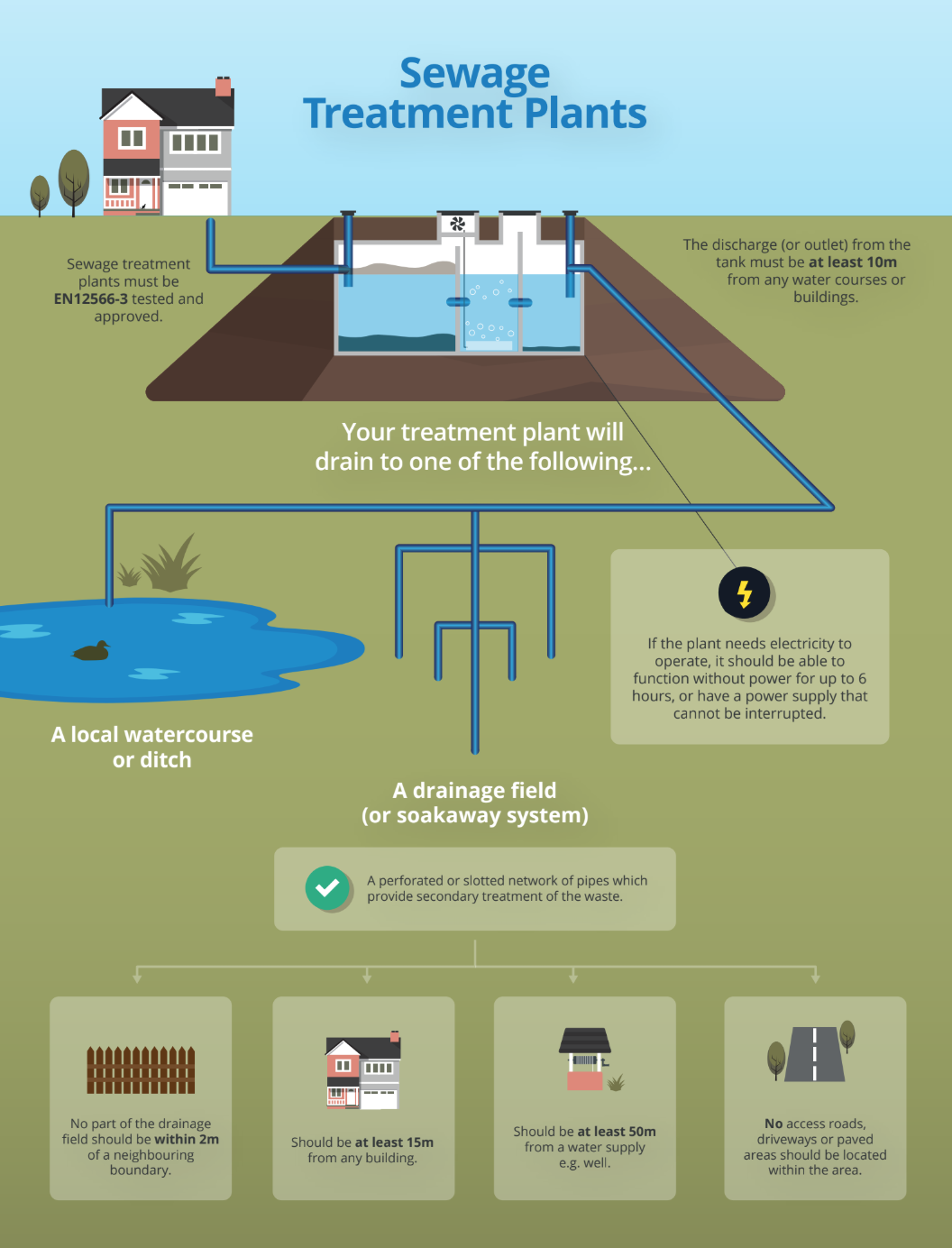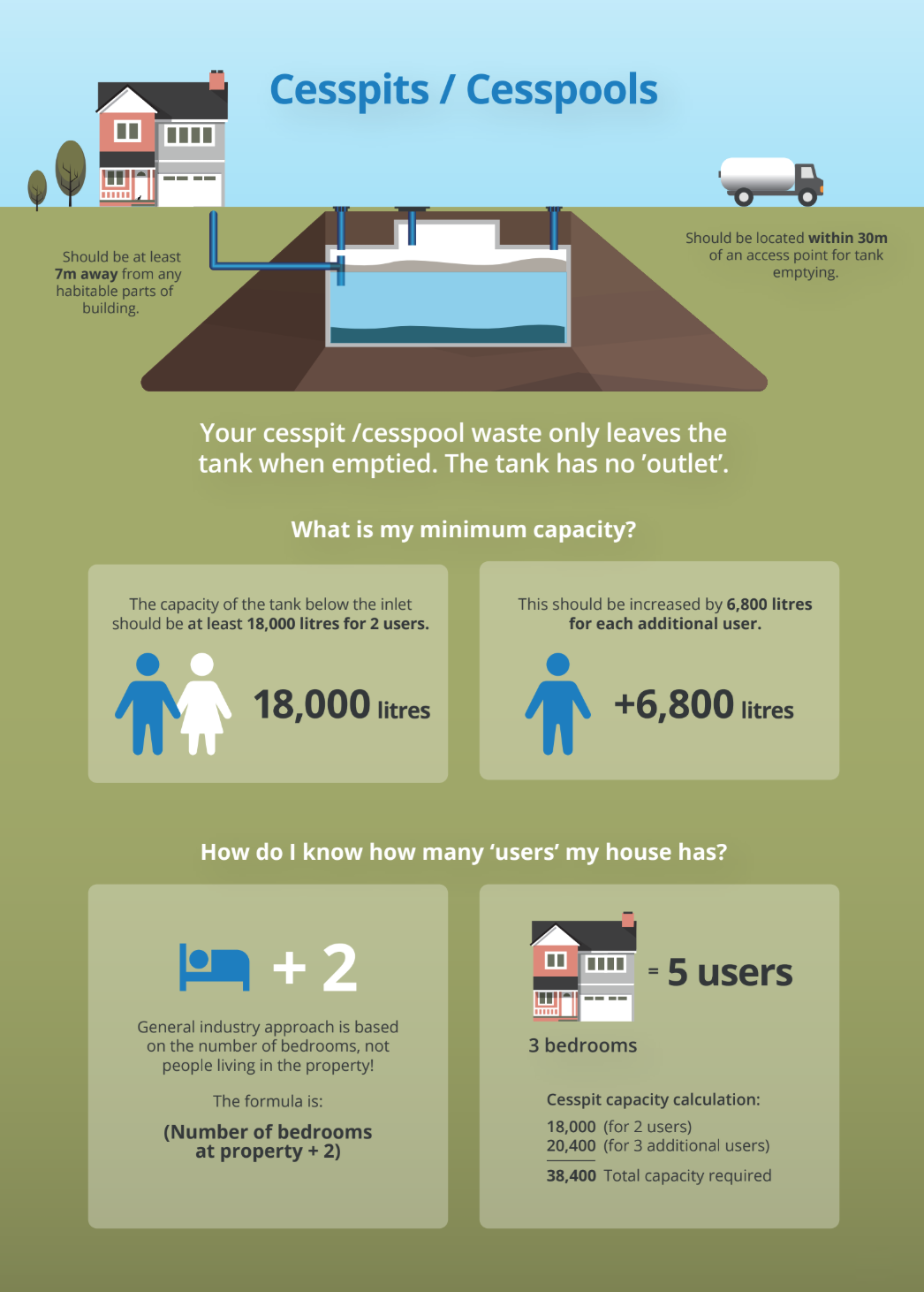Expert Guide
Off mains drainage regulations
This quick and easy guide will walk you through the main rules and regulations you need to be aware of, whether you have a septic tank, cesspit or sewage treatment plant.

An introduction to the Regulations
Owning a property with a septic tank, sewage treatment plant or cesspit isn’t always straightforward, and there are a number of regulations in place that you need to be aware of. These regulations perform an important role in making sure that drainage systems operate as they should do, and in reducing the risk of them polluting the environment.

Staying on the right side of the law
It’s really important that you stay on the right side of the law as far as drainage systems go, because not adhering to the regulations isn’t only potentially bad for the environment, it can also land you in trouble with your Local Authority and/or the Environment Agency.
They have the authority to test any off mains drainage system they think might be causing a problem, and can take action against you if they find any issues which remain unresolved.
Understanding regulations can be a challenge at the best of times, particularly when they relate to drainage systems which sit out of sight underground.
We have pored through pages and pages of documents, pulled out the most important bits, and put them into diagrams that we hope will make it easier to understand.
This Quick Guide will walk you through the main regulations you need to be aware of, whether you have a septic tank, cesspit or sewage treatment plant.
Not sure what type of drainage system you have? Here's a handy guide to talk you through the differences.
Remember, whilst the regulations put the burden of responsibility on the property owner, we are here to help you make sense of it all, and guide you on what exactly that means for your property.
Please note that this guide is a summary of the main points in current regulations affecting off mains drainage systems, and it isn’t intended to provide legal advice.
Septic Tank Regulations
Septic tanks should be at least 7 metres away from any habitable parts of the building. They should also be located within 30 metres of an access point so that the tank can be emptied.
Most septic tanks will either drain in to a local watercourse or ditch, a soakaway system or a drainage field. The General Binding Rules for Small Sewage Discharges state that septic tanks should only discharge to a drainage field, and that discharges to a watercourse or ditch are no longer allowed. This is because a septic tank provides very little treatment of the waste, and it is no longer considered safe to allow this waste to leave the septic tank and enter into watercourses without some form of further treatment - which can best be provided by a drainage field.
Guidance on the General Binding Rules outlines your options, if your septic tank does not currently discharge to a drainage field:
`If your septic tank discharges directly to a watercourse, you need to do one of the following as soon as possible:
- connect to mains sewer
- install a drainage field (also known as an infiltration system) so the septic tank can discharge to ground instead
- replace your septic tank with a small sewage treatment plant
You must have plans in place to carry out this work within a reasonable timescale, typically 12 months.'
Historically, the legislation stated that if your drainage system was not compliant. it needed to be upgraded or replaced by 1st January 2020. However, as the deadline passed, the guidance was also updated to provide the timescale above.
Furthermore, if you are buying or selling a property with a septic tank, the guidance states:
`If you are buying or selling a property with a septic tank that discharges directly to a watercourse, you should agree with the buyer or seller who will be responsible for the replacement or upgrade of the existing treatment system. You should agree this as a condition of sale.'
A drainage field is a perforated or slotted network of pipes which provide secondary treatment of the waste.
The drainage field should:
- be at least 10 metres from a watercourse.
- be at least 15 metres from any building.
- be at least 50 metres from a water supply (e.g. well).
- not be near any access roads, driveways or paved areas.

Sewage Treatment Plant Regulations
Sewage treatment plants must be EN12566-3 tested and approved. The discharge (or outlet) from the tank must be at least 10 metres from any water courses or buildings. If the plant needs electricity to operate, it should be able to function without power for up to 6 hours, or have a power supply that cannot be interrupted.
Your treatment plant will either drain in to a local watercourse or ditch or a drainage field (or soakaway system).
A drainage field (or soakaway system) is a perforated or slotted network of pipes which provide secondary treatment of the waste.
- No part of the drainage field should be within 2 metres of a neighbouring boundary.
- It should be at least 15 metres from any building.
- It should be at least 50 metres from a water supply (e.g. well).
- No access roads, driveways or paved areas should be located within the area.

Cesspit and Cesspool Regulations
Cesspit and Cesspools should be at least 7 metres away from any habitable parts of the building. They should be located within 30 metres of an access point for tank emptying.
Your cesspit/cesspool waste only leaves the tank when emptied. The tank has no ’outlet’.
What is my minimum capacity?
The capacity of the tank below the inlet should be at least 18,000 litres for 2 users. This should be increased by 6,800 litres for each additional user.
How do I know how many ‘users’ my house has?
The general industry approach is based on the number of bedrooms, not
people living in the property. The formula is Number of bedrooms
at property + 2.
For example, the Cesspit capacity calculation for a 3 bedroom house would be:
Number of bedrooms (3) +2 = 5
It's 18,000 for 2 users + (6,800 x 3) 20,400 for 3 additional users equalling 38,400 total capacity.

Useful links
We hope that this guide has given you all the information you need to stay on the right side of regulations affecting septic tanks, cesspits and sewage treatment plants.
Please remember that if you are in Scotland, Wales or Northern Ireland there may be some regional variations, so it’s always best to check before you undertake any works.
Here are some useful links...
Natural Resources Wales (NRW)
https://naturalresources.wales/permits-and-permissions/water-discharges/?lang=en
Scottish Environmental Protection Agency (SEPA)
https://www.sepa.org.uk/regulations/water/small-scale-sewage-discharges/
Northern Ireland Environment Agency (NIEA)
https://www.daera-ni.gov.uk/articles/regulating-water-discharges

Got some questions?
We are a friendly team of specialists with decades of combined experience. We're here to help.

Got some questions?
We are a friendly team of specialists with decades of combined experience. We're here to help.



